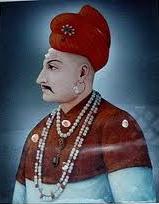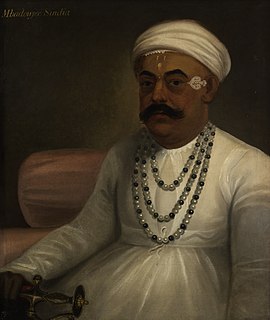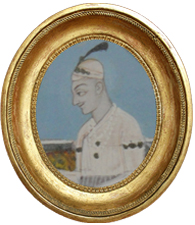Related Research Articles

Baji Rao I, born as Visaji, also known as Bajirao Ballal, was the 7th Peshwa of the Maratha empire. His relationship with his Muslim wife, a subject of controversy, has been adapted in Indian novels and cinema.

The Peshwa was the appointed Prime Minister of the Maratha Empire of the Indian subcontinent. Originally, the Peshwas served as subordinates to the Chhatrapati ; later, under the Bhat family, they became the de facto leaders of the Maratha Confederacy with the Chhatrapati becoming a nominal ruler. During the last years of the Maratha Empire, the Peshwas themselves were reduced to titular leaders, and remained under the authority of the Maratha nobles and the British East India Company.
Scindia dynasty, is a Hindu Maratha dynasty of Kunbi origin that ruled the erstwhile State of Gwalior. It had the patel-ship of Kumberkerrab in Wai. It was founded by Ranoji Scindia, who started as a personal servant of the Peshwa Bajirao I. Ranoji and his descendents along with their rivals the Holkars, played a leading role during the Maratha ascendency in North india during the 18th century. The Gwalior state was a princely state under the British Raj during the 19th and the 20th centuries. After India's independence in 1947, several members of the Sindhia family went on to join Indian politics.

Shrimant Peshwa Balajirao Bhat, also known as Nana Saheb, was the 8th Peshwa of the Maratha Empire in India. He was appointed as Peshwa in 1740 upon the death of his illustrious father, the Peshwa Bajirao I.
Shinde is a clan of the Maratha clan system of Kunbi origin. Variations of the name include Scindia, Sindhia, Sindia. The Shinde last name may be also found in the Dalit community.

The Battle of Palkhed was fought on February 28, 1728 at the village of Palkhed, near the city of Nashik, Maharashtra, India between the Maratha Empire Peshwa, Baji Rao I and the Nizam-ul-Mulk, Asaf Jah I of Hyderabad wherein, the Marathas defeated the Nizam.

Mahadaji Shinde also spelled as Mahadji Scindia was a Maratha Statesman and ruler of Ujjain in Central India. He was the fifth and the youngest son of Ranoji Rao Scindia, the founder of the Scindia dynasty.

Salabat Jung was born as Mir Sa'id Muhammad Khan Siddiqi Bayafandi on 24 November 1718. He was the 3rd son of Nizam-ul-Mulk. He was appointed as Naib Subahdar to his elder brother, Ghazi ud-Din Khan Feroze Jung II, the Prime Minister of Mughal Empire, with the title Salabat Jung. He was invested by Imperial firman, at Aurangabad, Maharashtra, 12 September 1749. He was granted the titles of Khan Bahadur and Salabat Jung during his father's lifetime.

Gwalior state was a semi-autonomous Maratha state. It was focused in modern-day Madhya Pradesh, arising due to the rise of the Maratha Empire and fragmentation of the Mughal Empire.
The Maratha Conquests were a series of conquests in the Indian subcontinent which led to the building of the Maratha Empire. These conquests were started by Shivaji in 1659 from the victory at the Battle of Pratapgad against Bijapur. The expansion of the empire was limited and interrupted by the Mughal conquests of south India by Emperor Aurangzeb. Marathas were forced to defend their territories against the overwhelmingly strong Mughal army in the 27 years long Deccan wars. They were able to defend their territories and gain an upper hand over Mughals in the sustained conflict.

Sadashivrao Peshwa was son of Chimaji Appa and Rakhmabai and the nephew of Bajirao Peshwa. He was a finance minister during the reign of Maratha emperor Chhatrapati Rajaram II. He served as the Sardar Senapati (Commander-in-Chief) of the Maratha army at the third battle of Panipat.

Shrimant Peshwa Madhav Rao Bhat II was the 12th Peshwa of the Maratha Empire in India, from his infancy. He was known as Sawai Madhav Rao or Madhav Rao Narayan. He was the posthumous son of Narayanrao Peshwa, murdered in 1773 on the orders of Raghunathrao. Madhavrao II was considered the legal heir, and was installed as Peshwa by the Treaty of Salbai in 1782 after First Anglo-Maratha War.

Ranoji Scindia was the founder of the Scindia dynasty. He was a noble subhedar of the Maratha Empire in present-day India. He rose to prominence while serving Bajirao I Peshwa. He was one of the early officers along with Malharao Holkar to help spread the Maratha rule to northern states and was given the estate of Ujjain to rule by the Peshwas, during the reign of the Maratha Emperor Shahu I.
The Battle of Rakshasbhuvan was fought on 10 August 1763. After the defeat of the Marathas at the Battle of Panipat, their rivals started seizing the opportunity to recover their losses in the past at the hands of Marathas. Particularly, the Nizam of Hyderabad wanted to recover territory he had lost at the Battle of Udgir where all of his dukes and earls were killed. He decided to launch a war on the Marathas.

The Great Maratha is an Indian historical drama television series directed by Sanjay Khan and produced by Numero Uno International Limited. The drama aired on DD National. The series is based on the life of Mahadaji Shinde. The show comprised 47 episodes. The music was composed by Mohammed Zahur Khayyam.

Dattaji Rao Shinde, also known as Dattaji Rao Scindia, was the second son of Ranoji Rao Shinde and Maina Bai, alias Nimba Bai. His elder brother was Jayappaji Rao Shinde and his younger brother was Jyotiba.
Tukoji Rao Scindia aka Baba Sahib was the fourth son of Ranoji Rao Scindia and elder brother of Mahadaji Scindia. He was killed at the Third Battle of Panipat, 14 January 1761. He was also father of Kadarji Rao Scindia and Anand Rao Scindia and grandfather of Daulat Rao Scindia.
Amrut Rao was a Maratha noble, and the adopted son of Peshwa Raghunath Rao. In 1803, Yashwant Rao Holkar invaded Pune and deposed his adoptive brother Peshwa Baji Rao II. Subsequently, Holkar set up an ad hoc council nominally headed by Amrut Rao, and ran the Peshwa's government in his name. Holkar also installed Amrut Rao's son Vinayak Rao as the Peshwa to strengthen the legal status of his government, because Vinayak had been adopted by the widow of the deceased Peshwa Madhav Rao II. However, Baji Rao sought assistance from the British East India Company, whose advance forced Amrut Rao and his son to flee Pune. Subsequently, Amrut Rao signed a treaty with the British, agreeing to give up all claims over the Peshwa's office in return for a pension and an estate in Bundelkhand.
Apa Khande Rao was a general under Maharaja Mahadaji Scindia of the Scindia dynasty that ruled Gwalior State. He brought Mughal emperor Shah Alam II, and most of Haryana under the control of Maratha Empire in 1790s. He joined the maratha army after the Battle of Lalsot against the Rajput kingdoms of Jaipur and Jodhpur. He had commissioned the services George Thomas to conquer Haryana by subduing Rajputs of Rajasthan, Kachawa Shekhawat thakur rulers of Haryana and Shekhawati, Sikhs misl of Haryana, Mughals and Bhatti Muslim Rajputs.
Capture of Delhi is the 1771 battle where the forces of Mahadji Shinde captured Delhi and the Mughal Emperor Shah Alam II was restored to the throne with the help of Mahadji. Marathas capture Delhi by defeating Afghans under Najib Khan. With this battle they regained their lost supremacy in North India after the Third Battle of Panipat and conquered much of the lost territories which they lost after the Third Battle of Panipat.
References
- ↑ N. G. Rathod (1994). The Great Maratha Mahadaji Scindia. Sarup & Sons. ISBN 9788185431529.